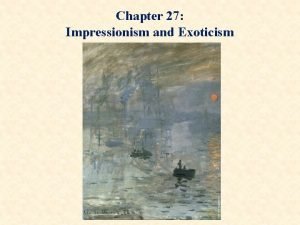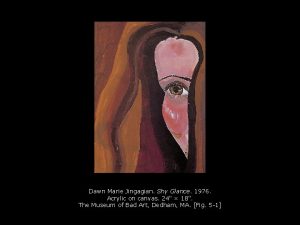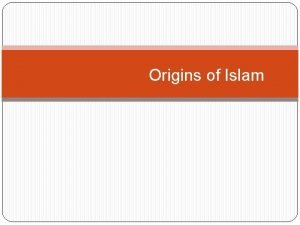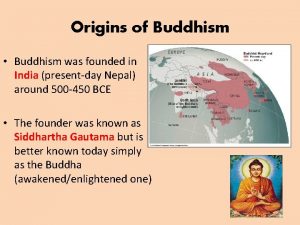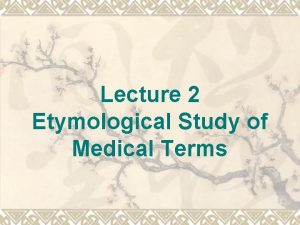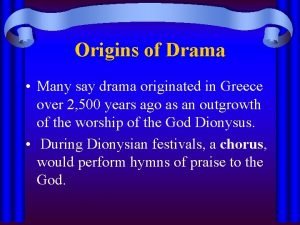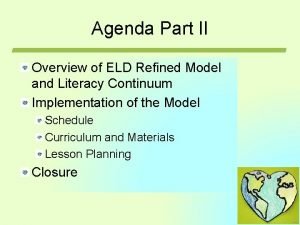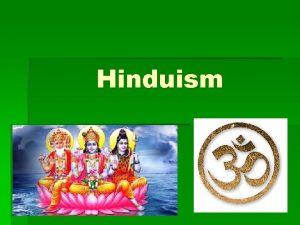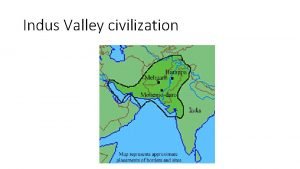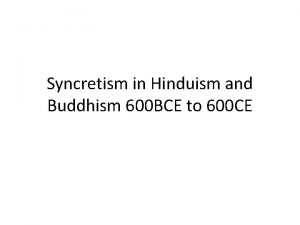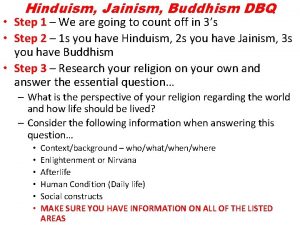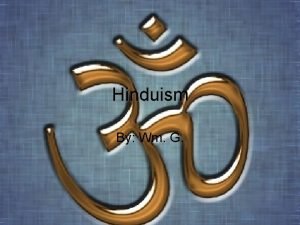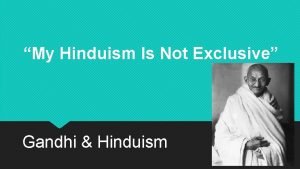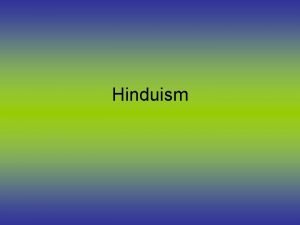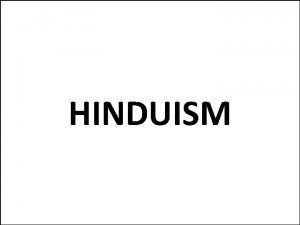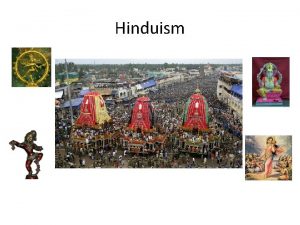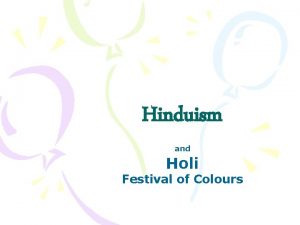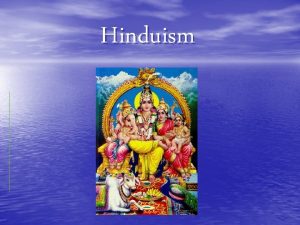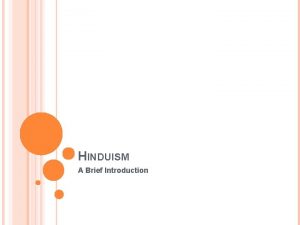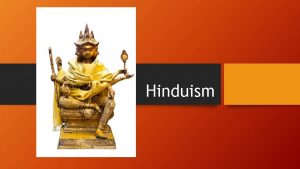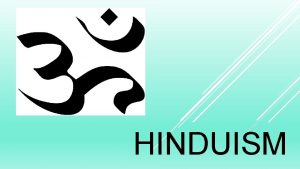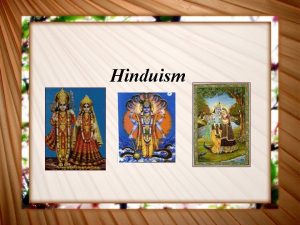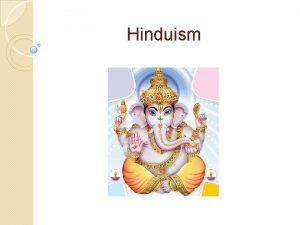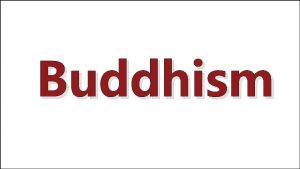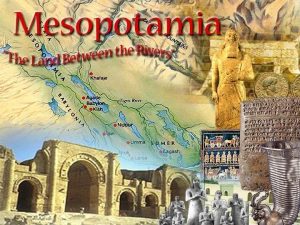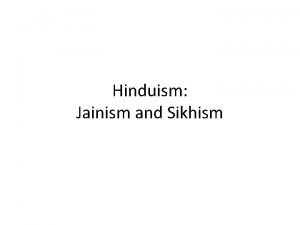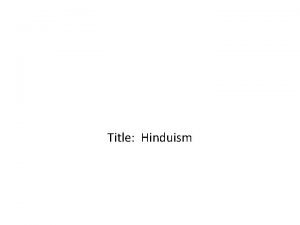Hinduism Hinduism At a Glance Hinduism originated around


















































- Slides: 50

Hinduism

Hinduism: At a Glance • Hinduism originated around the Indus Valley near the River Indus in modern day Pakistan. • About 80% of the Indian population regard themselves as Hindu. • Most Hindus believe in a Supreme God, whose qualities and forms are represented by the multitude of deities which emanate from him. • Hindus believe that existence is a cycle of birth, death, and rebirth, governed by Karma. • Hindus believe that the soul passes through a cycle of successive lives and its next incarnation is always dependent on how the previous life was lived. • The main Hindu texts are the Vedas and their supplements (books based on the Vedas). Veda is a Sanskrit word meaning 'knowledge'. These scriptures do not mention the word 'Hindu' but many scriptures discuss dharma, which can be rendered as 'code of conduct', 'law', or 'duty' • Hindus celebrate many holy days, but the Festival of Lights, Diwali is the best known. • The 2001 census recorded 559, 000 Hindus in Britain, around 1% of the population.

Hinduism Concepts: Atman • Atman means 'eternal self'. The atman refers to the real self beyond ego or false self. It is often referred to as 'spirit' or 'soul' and indicates our true self or essence which underlies our existence. • The idea of atman entails the idea of the self as a spiritual rather than material being and thus there is a strong dimension of Hinduism which emphasizes detachment from the material world and promotes practices such as asceticism. Thus it could be said that in this world, a spiritual being, the atman, has a human experience rather than a human being having a spiritual experience.

Hinduism Concepts: Dharma • Acting virtuously does not mean precisely the same for everyone; different people have different obligations and duties according to their age, gender, and social position. Dharma is universal but it is also particular and operates within concrete circumstances. Each person therefore has their own dharma known as sva-dharma. What is correct for a woman might not be for a man or what is correct for an adult might not be for a child.

Hinduism Concepts: Varna • An important idea that developed in classical Hinduism is that dharma refers especially to a person's responsibility regarding class (varna) and stage of life (ashrama). This is called varnashrama-dharma. In Hindu history the highest class, the Brahmins, adhered to this doctrine. The class system is a model or ideal of social order that first occurs in the oldest Hindu text, the Rig Veda and the presentday caste (jati) system may be rooted in this. The four classes are: • Brahmans or Brahmins - the intellectuals and the priestly class who perform religious rituals • Kshatriya (nobles or warriors) - who traditionally had power • Vaishyas (commoners or merchants) - ordinary people who produce, farm, trade and earn a living • Shudras (workers) - who traditionally served the higher classes, including laborers, artists, musicians, and clerks

Hinduism Concepts: Karma & Samsara • Karma is a Sanskrit word whose literal meaning is 'action'. It refers to the law that every action has an equal reaction either immediately or at some point in the future. Good or virtuous actions, actions in harmony with dharma, will have good reactions or responses and bad actions, actions against dharma, will have the opposite effect. • This process of reincarnation is called samsara, a continuous cycle in which the soul is reborn over and over again according to the law of action and reaction. At death many Hindus believe the soul is carried by a subtle body into a new physical body which can be a human or non-human form (an animal or divine being). The goal of liberation (moksha) is to make us free from this cycle of action and reaction, and from rebirth.

Hinduism Concepts: Purushartha • Hinduism developed a doctrine that life has different goals according to a person's stage of life and position. These goals became codified in the 'goals of a person' or 'human goals', the purusharthas, especially in sacred texts about dharma called 'dharma shastras' of which the 'Laws of Manu' is the most famous. In these texts three goals of life are expressed, namely virtuous living or dharma, profit or worldly success, and pleasure, especially sexual pleasure as a married householder and more broadly aesthetic pleasure. A fourth goal of liberation (moksha) was added at a later date. The purusharthas express an understanding of human nature, that people have different desires and purposes which are all legitimate in their context.

Hinduism Concepts: Brahman and God • Brahman is a Sanskrit word which refers to a transcendent power beyond the universe. As such, it is sometimes translated as 'God' although the two concepts are not identical. Brahman is the power which upholds and supports everything. According to some Hindus this power is identified with the self (atman) while others regard it as distinct from the self. • Most Hindus agree that Brahman pervades everything although they do not worship Brahman. Some Hindus regard a particular deity or deities as manifestations of Brahman. • Most Hindus believe in God but what this means varies in different traditions. The Sanskrit words Bhagavan and Ishvaramean 'Lord' or 'God' and indicate an absolute reality who creates, sustains and destroys the universe over and over again. It is too simplistic to define Hinduism as belief in many gods or 'polytheism'. Most Hindus believe in a Supreme God, whose qualities and forms are represented by the multitude of deities which emanate from him. God, being unlimited, can have unlimited forms and expressions.

Hinduism Concepts: Guru • The terms guru and acharya refer to a teacher or master of a tradition. The basic meaning is of a teacher who teaches through example and conveys knowledge and wisdom to his disciples. The disciple in turn might become a teacher and so the lineage continues through the generations. • Gurus are generally very highly revered and can become the focus of devotion (bhakti) in some traditions. A fundamentally important teaching is that spiritual understanding is conveyed from teacher to disciple through a lineage and when one guru passes away he or she is usually replaced by a successor. One guru could have more than one successor which leads to a multiplication of traditions.

Hinduism: Beliefs

Brahman God or gods? Contrary to popular understanding, Hindus recognize one God, Brahman, the eternal origin who is the cause and foundation of all existence. The gods of the Hindu faith represent different expressions of Brahman. Different Hindu communities may have their own divinities whom they worship, but these are simply different ways of approaching the Ultimate. Hindus recognize three principal gods: • Brahma, who creates the universe • Vishnu, who preserves the universe • Shiva, who destroys the universe.

Brahma is the Creator. However, Brahma is not worshipped in the same way as other gods because it is believed that his work - that of creation - has been done. Hindus worship other expressions of Brahman (not Brahma), which take a variety of forms. Hindus are often classified into three groups according to which form of Brahman they worship: • Those who worship Vishnu (the preserver) and Vishnu's important incarnations Rama, Krishna and Narasimha; • Those who worship Shiva (the destroyer) • Those who worship the Mother Goddess, Shakti, also called Parvati, Mahalakshmi, Durga or Kali.

Vishnu • Vishnu, the preserver, is believed to be linked to a very early sun god and is considered by his worshippers to be the greatest among the gods. He is also referred to as Narayana. • Vishnu preserves and protects the universe and has appeared on the earth through his avatars (incarnations) to save humankind from natural disasters or from tyranny. • The most well-known avatars are Rama (see Ramayana), Krishna, who destroyed the wicked and established a new order, Buddha, the founder of Buddhism, and Kalki. • Vishnu is represented in sculpture and painting in human form, often painted blue. • Lakshmi is the consort of Vishnu who has appeared as the wife of each of Vishnu's incarnations, including Sita, wife of Prince Rama, and Rukmini, wife of Krishna. • She is the goddess of wealth and good fortune who is offered special worship during the Divali festival.

Shiva • The god Shiva is part of the Hindu Trinity, along with Vishnu and Brahma. • He is considered to be everything by those who worship him: creator, preserver and destroyer. In Shiva, the opposites meet. • Shiva the destroyer is a necessary part of the trinity because, without destruction, there can be no recreation. • His city is Varanasi, and any Hindu who dies there is believed to go straight to heaven. • Shiva is the source of both good and evil who combines many contradictory elements. • In pictures and sculptures, Shiva is represented as Lord of the Dance who controls the movement of the universe. He is also associated with fertility. • Shiva has many consorts, including Kali, often portrayed as wild and violent, Parvati, renowned for her gentleness, and Durga, a powerful goddess created from the combined forces of the anger of several gods.

The Great Goddess (Mahadevi) • The great Goddess appears as a consort of the principal male gods and encompasses the thousands of local goddesses or matas. These can be both beautiful and benign, like Lakshmi, or all-powerful destructive forces like Kali. • Great Goddess shrines are associated with agriculture and fertility and the female energy, or shakti, is important in ancient texts known collectively as the Tantras. • Shakti is contrasted with Shiva, whose masculine consciousness is powerless without the creative female energy.

Other Vedic gods Indra, the god of storms. • Indra was once the Vedic king of all gods but has, over time, lost some influence. • Indra's main function is in leading the warriors (see caste system). • Indra fights not only human enemies, but also demons. Agni is the Vedic god of fire. • He is one of the supreme gods of the Rig Veda. • Agni is believed to take the offerings to the other world through fire. • Agni is represented by the ram. Varuna is the third Vedic god whose influence persists today. • Varuna presides over the orderliness of the universe. • Varuna rules over the night sky. Varuna is believed to know everything. • Varuna is the god of truth and moral judgements. Varuna knows the secrets of all hearts.

History of Hinduism

History of Hinduism • Hinduism's early history is the subject of much debate for a number of reasons. • Firstly, in a strict sense there was no 'Hinduism' before modern times, although the sources of Hindu traditions are very ancient. • Secondly, Hinduism is not a single religion but embraces many traditions. • Thirdly, Hinduism has no definite starting point. The traditions which flow into Hinduism may go back several thousand years and some practitioners claim that the Hindu revelation is eternal. • Although there is an emphasis on personal spirituality, Hinduism's history is closely linked with social and political developments, such as the rise and fall of different kingdoms and empires. The early history of Hinduism is difficult to date and Hindus themselves tend to be more concerned with the substance of a story or text rather than its date.

Hindu Notions of Time • Hindus in general believe that time is cyclical, much like the four seasons, and eternal rather than linear and bounded. Texts refer to successive ages (yuga), designated respectively as golden, silver, copper and iron. • During the golden age people were pious and adhered to dharma (law, duty, truth) but its power diminishes over time until it has to be reinvigorated through divine intervention. • With each successive age, good qualities diminish, until we reach the current iron or dark age (kali yuga) marked by cruelty, hypocrisy, materialism and so on. Such ideas challenge the widespread, linear view that humans are inevitably progressing.

Main Historical Periods • Although the early history of Hinduism is difficult to date with certainty, the following list presents a rough chronology. • Before 2000 BCE: The Indus Valley Civilization • 1500– 500 BCE: The Vedic Period • 500 BCE– 500 CE: The Epic, Puranic and Classical Age • 500 CE– 1500 CE: Medieval Period • 1500– 1757 CE: Pre-Modern Period • 1757– 1947 CE: British Period • 1947 CE–the present: Independent India

Hinduism: Worship

Puja • Hindu worship, or puja, involves images (murtis), prayers (mantras) and diagrams of the universe (yantras). • Central to Hindu worship is the image, or icon, which can be worshipped either at home or in the temple.

Individual rather than Cmmunal • Hindu worship is primarily an individual act rather than a communal one, as it involves making personal offerings to the deity. • Worshippers repeat the names of their favorite gods and goddesses, and repeat mantras. Water, fruit, flowers and incense are offered to god.

Worship at Home • The majority of Hindu homes have a shrine where offerings are made and prayers are said. • A shrine can be anything: a room, a small altar or simply pictures or statues of the deity. • Family members often worship together. Rituals should strictly speaking be performed three times a day. Some Hindus, but not all, worship wearing the sacred thread (over the left shoulder and hanging to the right hip). This is cotton for the Brahmin (priest), hemp for the Kshatriya (ruler) and wool for the vaishya (merchants).

Temple worship At a Hindu temple, different parts of the building have a different spiritual or symbolic meaning. • The central shrine is the heart of the worshipper • The tower represents the flight of the spirit to heaven • A priest may read, or more usually recite, the Vedas to the assembled worshippers, but any "twice-born" Hindu can perform the reading of prayers and mantras

Religious rites • Hindu religious rites are classified into three categories: • Nitya rituals are performed daily and consist in offerings made at the home shrine or performing puja to the family deities. • Naimittika rituals are important but only occur at certain times during the year, such as celebrations of the festivals, thanksgiving and so on. • Kamya are rituals which are "optional" but highly desirable. Pilgrimage is one such.

Worship and pilgrimage • Pilgrimage is an important aspect of Hinduism. It's an undertaking to see and be seen by the deity. • Popular pilgrimage places are rivers, but temples, mountains, and other sacred sites in India are also destinations for pilgrimages, as sites where the gods may have appeared or become manifest in the world.

Kumbh Mela • Once every 12 years, up to 10 million people share in ritual bathing at the Kumbh Mela festival at Allahabad where the waters of the Ganges and Jumna combine. • Hindus from all walks of life gathere for ritual bathing, believing that their sins will be washed away. • The bathing is followed by spiritual purification and a ceremony which secures the blessings of the deity.

River Ganges • The river Ganges is the holiest river for Hindus.

Varanasi • This city, also known as Benares, is situated on the banks of the Ganges and is one of the most important pilgrimage centers. • It is said to be the home of Lord Shiva where legend has it that his fiery light broke through the earth to reach the heavens. • A Hindu who dies at Varanasi and has their ashes scattered on the Ganges is said to have experienced the best death possible.

Hinduism: Ethics

Hinduism and Abortion • Hindu medical ethics stem from the principle of ahimsa - of non-violence. • When considering abortion, the Hindu way is to choose the action that will do least harm to all involved: the mother and father, the fetus and society. • Hinduism is therefore generally opposed to abortion except where it is necessary to save the mother's life. • Classical Hindu texts are strongly opposed to abortion: • one text compares abortion to the killing of a priest • another text considers abortion a worse sin than killing one's parents • another text says that a woman who aborts her child will lose her caste • Traditional Hinduism and many modern Hindus also see abortion as a breach of the duty to produce children in order to continue the family and produce new members of society. • Many Hindus regard the production of offspring as a 'public duty', not simply an 'individual expression of personal choice' (see Lipner, "The classical Hindu view on abortion and the moral status of the unborn" 1989). • In practice, however, abortion is practiced in Hindu culture in India, because the religious ban on abortion is sometimes overruled by the cultural preference for sons. This can lead to abortion to prevent the birth of girl babies, which is called 'female feticide'.

Abortion and Reincarnation • The doctrine of reincarnation, which sees life as a repeating cycle of birth, death and rebirth, is basic to Hindu thinking. • The doctrine of reincarnation can be used to make a strong case against abortion: • If a fetus is aborted, the soul within it suffers a major karmic setback. It is deprived of the opportunities its potential human existence would have given it to earn good karma, and is returned immediately to the cycle of birth, death and rebirth. Thus abortion hinders a soul's spiritual progress. • Reincarnation can also be used to make a case that abortion should be permitted. Under the doctrine of reincarnation, abortion only deprives the soul of one of many births that it will have. • The consequences of abortion in the framework of reincarnation are therefore not as bad as they are in those religions where a soul gets only one chance to be born and where abortion deprives the soul of all possibility of life.

Capital Punishment • There is no official Hindu line on capital punishment. However, Hinduism opposes killing, violence and revenge, in line with the principle of ahimsa (non-violence). • India still retains the death penalty, and the reasons for this are likely to be similar to be those suggested in the Buddhist section. • The debate on capital punishment in India was revived in 2004 by the case of Dhananjoy Chatterjee who had been sentenced for rape and murder. • At present more than 100 people are on death row in India, although the number of executions in that country is actually very low and the Indian Supreme Court has ruled that the death penalty should only be used in the rarest of rare cases.

Euthanasia, Assisted Dying, and Suicide • There are several Hindu points of view on euthanasia. • Most Hindus would say that a doctor should not accept a patient's request for euthanasia since this will cause the soul and body to be separated at an unnatural time. The result will damage the karma of both doctor and patient. • Other Hindus believe that euthanasia cannot be allowed because it breaches the teaching of ahimsa (doing no harm). • However, some Hindus say that by helping to end a painful life a person is performing a good deed and so fulfilling their moral obligations.

Killing • Killing (euthanasia, murder, suicide) interferes with the killed soul's progress towards liberation. It also brings bad karma to the killer, because of the violation of the principle of non-violence. • When the soul is reincarnated in another physical body it will suffer as it did before because the same karma is still present. • Death: The doctrine of karma means that a Hindu tries to get their life in a good state before they die, making sure that there is no unfinished business, or unhappiness's. They try to enter the state of a sannyasin - one who has renounced everything. • The ideal death is a conscious death, and this means that palliative treatments will be a problem if they reduce mental alertness. • The state of mind that leads a person to choose euthanasia may affect the process of reincarnation, since one's final thoughts are relevant to the process.

Euthanasia There are two Hindu views on euthanasia: • By helping to end a painful life a person is performing a good deed and so fulfilling their moral obligations • By helping to end a life, even one filled with suffering, a person is disturbing the timing of the cycle of death and rebirth. This is a bad thing to do, and those involved in the euthanasia will take on the remaining karma of the patient. • The same argument suggests that keeping a person artificially alive on a lifesupport machine would also be a bad thing to do • However, the use of a life-support machine as part of a temporary attempt at healing would not be a bad thing

Suicide Prayopavesa, or fasting to death, is an acceptable way for a Hindu to end their life in certain circumstances. Prayopavesa is very different from what most people mean by suicide: • it's non-violent and uses natural means; • it's only used when it's the right time for this life to end - when this body has served its purpose and become a burden; • unlike the suddenness of suicide, prayopavesa is a gradual process, giving ample time for the patient to prepare himself and those around him for his death; • while suicide is often associated with feelings of frustration, depression, or anger, prayopavesa is associated with feelings of serenity Prayopavesa is only for people who are fulfilled, who have no desire or ambition left, and no responsibilities remaining in this life. It is really only suitable for elderly ascetics. Hindu law lays down conditions for prayopavesa: • inability to perform normal bodily purification • death appears imminent or the condition is so bad that life's pleasures are nil • the decision is publicly declared • the action must be done under community regulation

War • Hinduism is a label that covers a wide range of Indian religious groups. While there are many differences between the various traditions they have a great deal in common. • Like most religions Hinduism includes both teachings that condemn violence and war, and teachings that promote it as a moral duty. • The teachings that condemn violence are contained in the doctrine of ahimsa, while those that permit it center around the Kshatriyas - the warrior caste.

Animal Ethics Because Hinduism is a term that includes many different although related religious ideas, there is no clear single Hindu view on the right way to treat animals, so what follows are generalizations to which there are exceptions. The doctrine of ahimsa leads Hindus to treat animals well: • Most Hindus are vegetarian • No Hindu will eat beef • • • Butchery and related jobs are restricted to people of low caste Most Hindus believe that non-human animals are inferior to human beings Cows are sacred to Hindus Some Hindu temples keep sacred animals Some Hindu gods have animal characteristics • Ganesh has the head of an elephant • Hanuman takes the form of a monkey

Cows • The cow is greatly revered by Hindus and is regarded as sacred. Killing cows is banned in India and no Hindu would eat any beef product.

Contraception • There is no ban on birth control in Hinduism. • Some Hindu scriptures include advice on what a couple should do to promote conception - thus providing contraceptive advice to those who want it. • However, most Hindus accept that there is a duty to have a family during the householder stage of life, and so are unlikely to use contraception to avoid having children altogether. • Because India has such a high level of population, much of the discussion of birth control has focused on the environmental issue of overpopulation rather than more personal ethics, and birth control is not a major ethical issue.

Holy Days

Diwali • Diwali, the Hindu festival of lights, is the most popular of all the festivals from South Asia. It is also an occasion for celebration by Jains and Sikhs. • The festival of Diwali extends over five days. Because of the lights, fireworks and sweets involved, it's a great favorite with children. • The festival celebrates the victory of good over evil, light over darkness and knowledge over ignorance, although the actual legends that go with the festival are different in different parts of India.

Rituals and Rites

Baby Rites • Hindus believe that it is the responsibility of each individual to continue the Hindu race and therefore soon after a couple are married, a prayer called Garbhadana (conception) is recited for fulfillment of one's parental obligations. • During the third month of pregnancy the ceremony of Punsavana (fetus protection) is performed. This is done for the strong physical growth of the fetus. • The Simantonnyana is performed during the seventh month. This is the equivalent of a baby shower and means 'satisfying the craving of the pregnant mother'. Prayers are offered for the mother and child with emphasis on healthy mental development of the unborn child. Hindus believe that mental state of a pregnant woman affects the unborn child. • Once the child enters the world, Jatakarma is performed to welcome the child into the family, by putting some honey in the child's mouth and whispering the name of God in the child's ear. • Other rituals include a naming ceremony (Namakarna), the Nishkarmana (the child's first trip out) and the Annaprasana, (the child's first taste of solid food). • The ear-piercing ceremony (Karnavedha) and first haircut (Mundan) ceremonies are also considered highly significant. These sacraments are performed on both the sexes. Hindus believe that the piercing of a hole in the lower lobes of the ear have benefits of acupuncture. • Head shaving is connected to the removal of impurities. • When the child reaches school-going age, the Upanayana (sacred thread) ceremony is performed. The three strands of the sacred thread represent the three vows (to respect the knowledge, the parents and the society) taken before the start of formal education. • Although Hindu scriptures explain the rituals, it is possible that Hindu rituals and rites will differ according to particular castes and regions.

Weddings Hindu sacraments are called 'sanskars' and the sacraments performed at the time of a wedding are called 'Vivah Sanskar'. This sanskar marks the start of the second and the most important stage of life called the 'Grihistha Ashrama' which involves setting up of a new family unit. Two individuals who are considered to be compatible form a lifelong partnership at this ceremony in which the responsibilities and duties of a householder are explained. The precise details and rituals performed in a wedding ceremony vary from region to region and often take several hours to complete. The main stages of a Hindu wedding are: Jayamaala • Firstly, the bride's parents welcome the bridegroom and his family at the boundary of the house where the wedding is taking place. A red kum-kum (kind of powder) mark is applied to their forehead. Members from both families are formally introduced, marking the start of relationship between two families. The bride and the bridegroom then exchange garlands (jayamaala) and declare: "Let all the learned persons present here know, we are accepting each other willingly, voluntarily and pleasantly. Our hearts are concordant and united like waters. " Madhu-Parka • The bridegroom is brought to a specially decorated altar called 'mandap' and offered a seat and a welcoming drink - a mixture of milk, ghee, yoghurt, honey and sugar. Gau Daan and Kanya Pratigrahan • 'Gau' means cow and 'Daan' means donation. Nowadays, the symbolic exchange of gifts, particularly clothes and ornaments takes place. The groom's mother gives an auspicious necklace (mangala sootra) to the bride. Mangla sootra is the emblem of marital status for a Hindu woman. 'Kanya' means the daughter and 'Pratigrahan' is an exchange with responsiveness on both sides. The bride's father declares that their daughter has accepted the bridegroom and requests them to accept her.

Weddings (continued) Vivaha-homa • A sacred fire is lit and the Purohit (Priest) recites the sacred mantras in Sanskrit. Oblations are offered to the fire whilst saying the prayers. The words "Id na mama" meaning "it is not for me" are repeated after the offerings. This teaches the virtue of selflessness required to run a family. • This is the ceremony of vows. The husband, holding his wife's hand, says "I hold your hand in the spirit of Dharma, we are both husband wife". • Shilarohan and Laaja Homa • Shilarohan is climbing over a stone/rock by the bride which symbolizes her willingness and strength to overcome difficulties in pursuit of her duties. Both gently walk around the sacred fire four times. The bride leads three times and the fourth time the groom leads. He is reminded of his responsibilities. The couple join their hands into which the bride's brothers pour some barley, which is offered to the fire, symbolizing that they all will jointly work for the welfare of the society. The husband marks the parting in his wife's hair with red kumkum powder for the first time. This is called 'sindoor' and is a distinctive mark of a married Hindu woman.

Weddings (continued) Surya Darshan and Dhruva Darshan • The couple look at the Sun in order to be blessed with creative life. They look in the direction of the Dhruva (Polar star) and resolve to remain unshaken and steadfast like the Polar star.

Weddings (continued) • Ashirvada (Blessings) • The couple are blessed by the elders and the priest for a long and prosperous married life. • It is important to clarify two misconceptions about Hindu marriages: arranged marriages and child marriages. • Hindu scriptures prohibit use of force or coercion in marriages. • Arranged marriages are based on agreement from both the bride and the groom, and should not be confused with forced marriages. • In the Vedic period, child marriages were strictly prohibited. Later, due to political and economical changes, some new social traditions started which deviated from the Vedic teachings. • Child marriages and the associated tradition of dowry were some of the deviations which reformist movements in modern times have attempted to correct. Child marriages are now banned by law in India, although reports suggest that the practice has not been eradicated.
 Hinduism at a glance
Hinduism at a glance Example of what goes around comes around
Example of what goes around comes around Goes around comes around meaning
Goes around comes around meaning At a glance leaflet
At a glance leaflet Brief history of french cuisine
Brief history of french cuisine Antiromanticism
Antiromanticism Weak corrective action qapi
Weak corrective action qapi Tax facts at a glance
Tax facts at a glance Environmental issues cloze notes 1 answer key
Environmental issues cloze notes 1 answer key How are glance-object pairs used in editing
How are glance-object pairs used in editing Parliamentary procedure at a glance
Parliamentary procedure at a glance Where do vikings come from
Where do vikings come from Hermana mayora
Hermana mayora Glance guest setup.exe
Glance guest setup.exe Audit latin meaning
Audit latin meaning Techniques of direct method of teaching english
Techniques of direct method of teaching english Drdp at a glance
Drdp at a glance Shy glance painting
Shy glance painting The scandal known as watergate originated from the
The scandal known as watergate originated from the Where is islam originated
Where is islam originated Happy godmothers day gif
Happy godmothers day gif Where did impressionism originated
Where did impressionism originated Where did medieval theatre originated
Where did medieval theatre originated The poem brook
The poem brook Lagaylay originated from
Lagaylay originated from This breed originated in french alps
This breed originated in french alps It is the blue print of nursing process
It is the blue print of nursing process Pliate
Pliate Types of agriculture map
Types of agriculture map Drdp preschool measures at a glance
Drdp preschool measures at a glance Where in india was buddhism founded
Where in india was buddhism founded Aise medical term
Aise medical term Teks resource system curriculum
Teks resource system curriculum Education at a glance 2015
Education at a glance 2015 Where drama originated
Where drama originated Where was graffiti originated
Where was graffiti originated Christianity at a glance
Christianity at a glance Rotary at a glance
Rotary at a glance Subdivision/sects of theravada buddhism
Subdivision/sects of theravada buddhism Eld standards az
Eld standards az Slide line dance
Slide line dance Badmintion history
Badmintion history Where did rock latino originate
Where did rock latino originate Macbeth map
Macbeth map Origins of sikhism
Origins of sikhism Reincarnation
Reincarnation Modern day indus valley
Modern day indus valley Syncretism in hinduism
Syncretism in hinduism Hinduism and buddhism dbq
Hinduism and buddhism dbq Indian social class
Indian social class The sudras
The sudras





